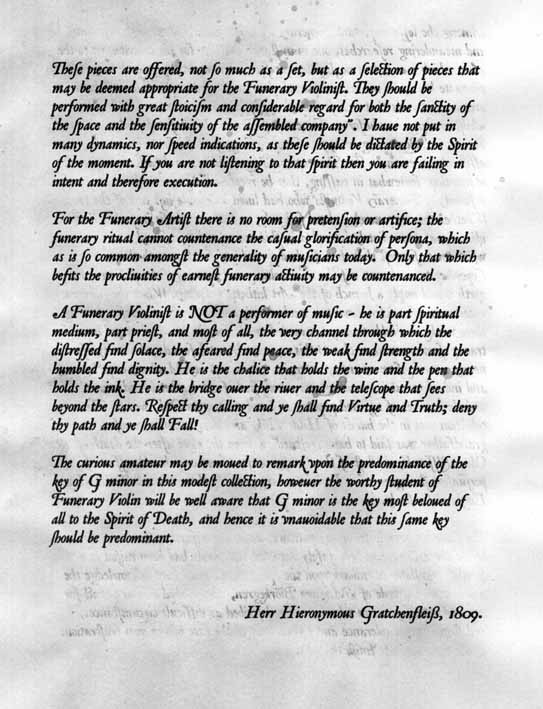The Hildesheim trunk was discovered in the soon to be demolished ruins of a church in Hildesheim, Germany. Its contents included a hand-written Testament, thought to be by Herr Gratchenfleiss himself, and a book of printed music in an edition dated 1823, with an introduction surprisingly written in English. It is thought they were placed there, inside a casket tomb in the crypt of the church, (that of Karl Finkel – who was a student of Herr Gratchenfleiss in the 1790s) to escape the destruction of the Funerary Purges some time in the 1830s. It is most unfortunate that water penetration and the other unsavoury contents of the tomb had caused the trunk itself to rust heavily and the contents to be largely destroyed by mould. The few fragments of the testament, together with a handful of the 100 or so pieces in the book, are all that are decipherable. We will never know whether these were the best or the worst of his many works, nor which pieces were composed when in his long career: those that have survived are certainly flawed, and it is well known from the accounts that we have, that he would improvise extravagantly around the written notes: but they do demonstrate a truly original imagination and a surprisingly modern sensibility.
The music itself is remarkable in many ways: its rigorous abandonment of functional harmony, looking back instead to a more modal style based upon shifting drones which allows for the occasional use of non-traditional scales; a considerable use of repetition far beyond even the most tedious composers of his day, yet without undermining the notion of a musical journey; the occasional burst of extraordinary dissonance unseen in any other composer since the renaissance, until the late works of Beethoven fifteen years after his death; the brevity of many of the works (making them momentary glimpses of an emotional state) which predates the later similar smaller works of Schumann by two decades; and his remarkably modern conception of violin technique, often treating it more as a rhythm and harmony instrument than a lyrical and melodic single voice. All of these idiosyncrasies are born of the music’s unique function – that of the funerary violinist; to express the inexpressible, to become the voice of the unnameable sorrows of mourning and to transfigure them into a vision of hope. It is clear from his Testament that he abhorred empty virtuosity, and many of these works could technically be played by the average student, but from accounts of his performances it can be assumed that his own playing was truly exceptional. In addition it is well known that he improvised around the notes, which implies that these works are really little more than sketches of spaces that he would explore more rigorously in live performance. Despite attempts to eradicate his legacy, attempts that were only truly undermined by the discovery of the Hildesheim trunk, it is clear that his vision had a considerable influence on later musicians and that without him, the later masterpieces of Paganini, Schumann, Chopin etc., to name but a few, may not have been written as they were.
